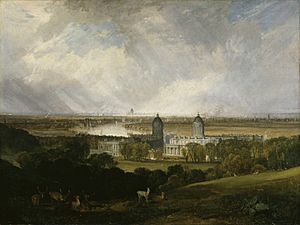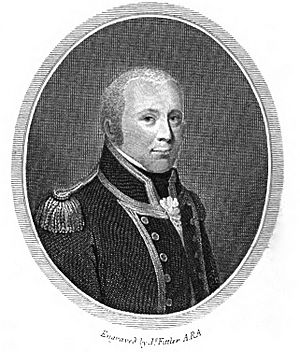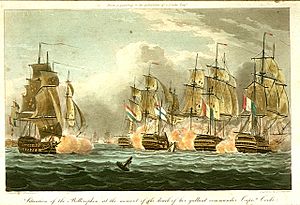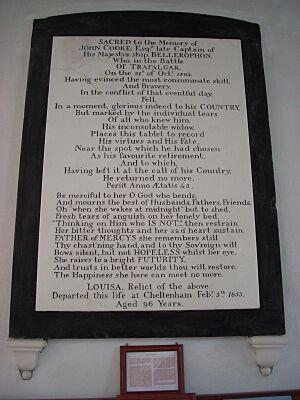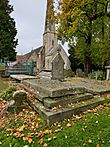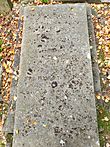John Cooke (Royal Navy officer) facts for kids
Quick facts for kids
John Cooke
|
|
|---|---|
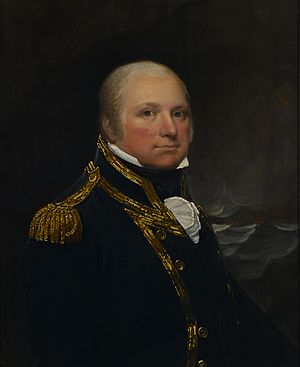
John Cooke, painted c. 1797–1803 by Lemuel Francis Abbott
|
|
| Born | 17 February 1762 Goodman's Fields, London, England |
| Died | 21 October 1805 (aged 43) HMS Bellerophon off Cape Trafalgar, off the coast of Spain |
| Allegiance | |
| Service/ |
|
| Years of service | 1776–1805 |
| Rank | Captain |
| Commands held |
|
| Battles/wars |
|
John Cooke (born February 17, 1762 – died October 21, 1805) was a brave officer in the Royal Navy. He served during the American Revolutionary War, the French Revolutionary Wars, and the early years of the Napoleonic Wars.
Cooke is most famous for how he died during the Battle of Trafalgar in 1805. His ship, HMS Bellerophon, was badly damaged. French sailors and marines from the ship Aigle boarded his ship. Cooke was killed fighting them, but his crew fought back. They successfully forced the French ship Aigle to surrender.
Cooke was not a well-known public figure, but other officers respected him greatly. After his death, memorials were placed in St Paul's Cathedral and his local church in Wiltshire.
John Cooke's Early Life
John Cooke was born on February 17, 1762. His father, Francis Cooke, worked for the Royal Navy in London. Francis was also the treasurer of the Greenwich Hospital.
John was baptized on March 5, 1762, at his family's home in London.
John Cooke first went to sea at age eleven on a small ship called HMS Greyhound. After this, he studied at a naval academy in Greenwich.
In 1776, at age thirteen, he became a midshipman on the large ship HMS Eagle. He served on Eagle for three years during the American Revolutionary War. He fought in battles along the American coast, including naval operations near the Battle of Rhode Island in 1778.
Cooke was promoted to lieutenant on January 21, 1779. He joined HMS Superb in the East Indies. However, he had to leave due to illness.
After recovering, Cooke studied in France for a year. In 1782, he rejoined the navy on the ship HMS Duke. He fought in the Battle of the Saintes.
After the war ended in 1783, Cooke continued to serve as first-lieutenant on HMS Europa. He later had to go home after a bad fall. In 1790, he joined HMS London but went ashore when the ship was taken out of service.
Commanding Frigates
When the French Revolutionary Wars began in 1793, Cooke returned to duty. He became first-lieutenant on HMS Royal George.
On February 21, 1794, Cooke was promoted to commander. He was given his first independent command, the small fire ship HMS Incendiary. Three months later, Incendiary helped relay signals during the Glorious First of June battle. Cooke saw the battle, but his ship was too small to fight.
After this battle, Cooke was promoted to post-captain on July 23, 1794. For a year, he served off Newfoundland on HMS Monarch. He then returned to Britain.
In 1796, he took command of the frigate HMS Nymphe. Nymphe helped blockade French ports. On March 9, 1797, Nymphe and HMS St Fiorenzo found French ships returning from an invasion attempt in Wales. The British ships chased down and captured the French ships Résistance and Constance. Cooke and his crew received prize money for this success.
However, Cooke was known for being very strict. This caused problems during the Spithead and Nore mutinies. His crew ordered him ashore. The navy quietly removed him from command.
Two years later, he returned to service on the new frigate HMS Amethyst. This was for an invasion of the Batavian Republic (now the Netherlands). Amethyst helped transport troops and later evacuate them.
In 1799 and 1800, Amethyst captured six French merchant ships. In 1801, Cooke helped capture the French frigate Dédaigneuse off Cape Finisterre. Amethyst was not damaged in this action. Soon after, Cooke captured a Spanish ship and a French privateer.
The Battle of Trafalgar
After a short break, Cooke was called back to duty in 1803 when the Napoleonic Wars began. He took command of HMS Bellerophon on April 25, 1805.
In May, a large French and Spanish fleet escaped from Toulon. Cooke was ordered to join a squadron blockading Cartagena. Later, he joined the blockade of Cádiz. Cooke was very excited to serve under Admiral Nelson. He said that fighting in a major battle with Nelson would be the highlight of his career.
The French and Spanish fleet left Cádiz on October 18, 1805. Nelson's fleet chased them down and fought them on October 21. Nelson divided his fleet into two lines. Cooke's ship, Bellerophon, was fifth in the southern line. This meant it was one of the first ships to engage the enemy. Cooke even told his officers Nelson's orders, in case he was killed.
Bellerophon quickly engaged the French ship Aigle. French soldiers on Aigle fired muskets at Bellerophon's deck, causing many casualties. Cooke, his first lieutenant William Cumby, and his master Edward Overton were on the quarterdeck. Cumby noticed Cooke was still wearing his uniform coat with special shoulder decorations, which marked him as the captain. Cooke knew this was dangerous but said, "It is too late to take them off. I see my situation, but I will die like a man."
The French captain of Aigle ordered his crew to board Bellerophon. Cooke bravely fought the French sailors who came onto his ship, shooting an enemy officer. Cumby went below deck to make sure the lower guns kept firing. When he returned, he found Cooke dead on the quarterdeck, hit by two musket balls. Cooke's last words were, "Let me lie quietly a minute. Tell Lieutenant Cumby never to strike."
Cumby took command of Bellerophon. He directed its fire at Aigle, forcing the French ship to surrender. Bellerophon suffered heavy losses, with 27 dead and 127 wounded. Cooke's body was buried at sea the day after the battle.
Cooke's Family and Legacy
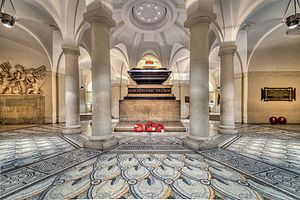
Many people in Britain mourned Cooke's death, just like they mourned Admiral Nelson's. Cooke's wife, Louisa, and their eight-year-old daughter, Louisa Charlotte, received many awards. These included a gold medal and a large silver vase.
On April 12, 1806, Louisa and Louisa Charlotte were given pensions by the British Government. Some of this money was used for a large plaque in St Andrew's Church in Donhead St Andrew, Wiltshire. This plaque remembers Cooke's life and death. A memorial was also placed for him in St Paul's Cathedral.
Other officers also paid tribute to Cooke. John Franklin, who later became a famous explorer, served on Bellerophon at Trafalgar. He said Cooke was "very gentlemanly and active."
Cooke married Louisa Hardy on June 15, 1790. Louisa was the daughter of Josiah Hardy, a former Governor of New Jersey. Cooke's wife, Louisa, lived until February 5, 1853, dying at age 96. She was buried at St Peter's Church, Leckhampton.
Their only child, Louisa Charlotte Cooke, was born on January 26, 1797. She married Abraham John Newenham Devonsher in 1820. Louisa Charlotte died on April 30, 1871, and was buried in Bouncer's Lane Cemetery, Cheltenham.
See also
- Bibliography of 18th–19th century Royal Naval history
- HMS Bellerophon
- John Cooke, Cooke's uncle and Vice-Chancellor of the University of Oxford from 1788 until 1792
- Sir Charles Hardy, Admiral of the Fleet and Governor of New York


